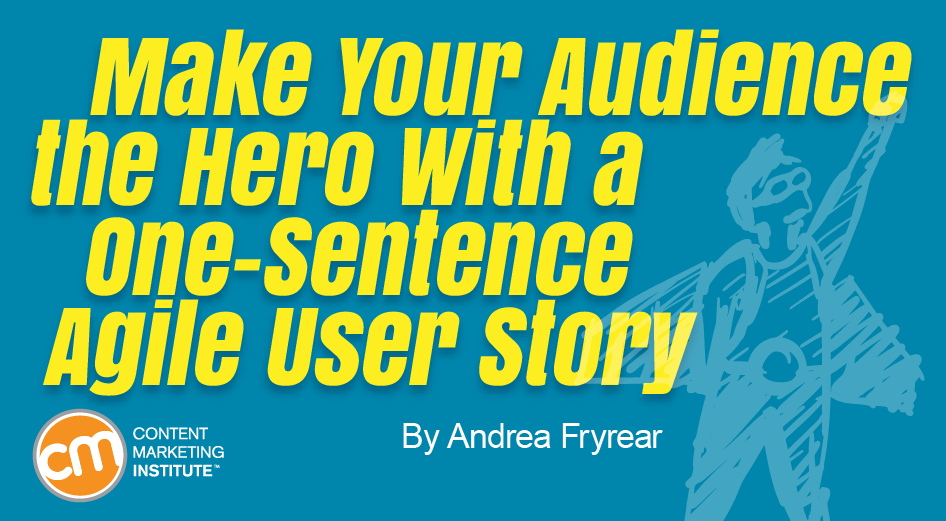What is a user story? User stories can be modified for content marketers as well. Rather than listing a bunch of SEO-friendly facts and calling it content marketing, create user stories that guide you toward thinking about how your content will help people. You don’t need to be on an Agile team to use this type of story. Here’s another way to look at what to include in a content marketing user story – use four core elements: A short, simple title Who the content is for (audience segment or persona) What that audience is looking for (usually the content type or channel) Why the audience cares about consuming this content (what problem they hope to solve) Create as many user stories as you need to cover the range of your audiences, content types, channels, and problems people are hoping to solve. In this case, you might create a user story for each blog post. The added details – importance, status, rough size, date created, and author – transform the card into a tool for tracking progress while producing each blog post. Where do user stories come from? What do your team’s user stories look like? She also writes for and edits The Agile Marketer a community of marketers on the front lines of the agile marketing transformation.

Once upon a time, there was an industry on the brink of implosion.
Its members were consistently delivering the work their bosses requested, but half the time it was so disconnected from what customers wanted that it was useless. Rework ran rampant. Projects spiraled out of control, coming in horrifyingly late and absurdly over budget. By the turn of the millennium, the time had come for drastic measures.
The industry is software development. One of those drastic measures was overhauling the relationship between developers and the people who use their software by employing a powerful tool known as the user story.

Since then, user stories have proven to be equally helpful outside the software world.
When user stories are properly configured and applied in a content marketing context, they put audience needs at the center of content production, support efficient teamwork, and encourage interdepartmental communication.
What is a user story?
Don’t be misled by the word “story.” A user story is not a story in any traditional sense of the word. In fact, it should be only a single sentence. It’s a tool that helps teams align their efforts on a shared sense of an audience and its needs.
The term “user story” was coined by an early pioneer of extreme programming, Kent Beck, who described them as “stories about what the software does,” stories that “generate energy and interest and a vision in your listener’s mind.”
If Kent had been a content marketer, he might have described user stories as stories about what an organization’s content enables people to do, stories that generate energy and interest and a vision in your content team’s minds.
Kent argues that, rather than base software on massive specifications documents, developers should listen to people talk about the cool stuff they want software to do, like automatically fill in the city and state when they enter their ZIP code.
Since those early days, user stories for software development have evolved into a standard format:
As a [USER ROLE], I would like [A CERTAIN FEATURE] so I can [ACHIEVE THIS OUTCOME].
User stories can be modified for content marketers as well. There’s no one right structure. It may look something like this:
As a [PERSONA], I would like [THIS KIND OF CONTENT] so I can [ACCOMPLISH THIS].
In my recent Agile marketing workshop at the Intelligent Content Conference, I gave this example of a user story:
Don’t let this fill-in-the-blank template constrain you. Adapt it and use it in whatever way helps your team generate content ideas that will resonate and lead to conversions. All that matters is that you get the benefits of user stories – audience focus and clarity of purpose. Rather than listing a bunch of SEO-friendly facts and calling it content marketing, create user stories that guide you toward thinking about how your content will help people.
You don’t need to be on an Agile team to use this type of story. These stories can help any marketing team identify the right stories to tell.
Here’s another way to look at what to include in a content marketing user story – use four core elements:
- A short, simple title
- Who the content is for (audience segment or persona)
- What that audience is looking for (usually the content type or channel)
- Why the audience cares about consuming this content (what problem they hope to solve)

Create as many user stories as you need to cover the range of your audiences, content types, channels, and problems people are hoping to solve.
What details should be in user stories to track content creation?
…

COMMENTS